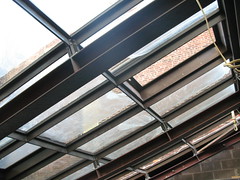 Reflective coatings on window glazing or glass reduce the transmission of solar radiation, blocking more light than heat. Therefore, they greatly reduce a window's visible transmittance (VT) and glare, but they also reduce a window's solar heat gain coefficient (SHGC).
Reflective coatings on window glazing or glass reduce the transmission of solar radiation, blocking more light than heat. Therefore, they greatly reduce a window's visible transmittance (VT) and glare, but they also reduce a window's solar heat gain coefficient (SHGC).
Reflective coatings usually consist of thin, metallic layers. They come in a variety of metallic colors, including silver, gold, and bronze.
Reflective window glazing is commonly used in hot climates where solar heat gain control is critical. However, the reduced cooling energy demands they achieve can be offset by the
resulting need for additional electrical lighting, so reflective glass is mostly used just for special applications
resulting need for additional electrical lighting, so reflective glass is mostly used just for special applications
Preventing Winter Heat Loss
• Double glazed insulating windows substantially reduce winter heat loss. Up to 30% reduction in heat loss can be achieved with normal double glazing alone.
• Double glazing should be considered where it is impractical or undesirable to incorporate internal window coverings, for example: clerestory & highlight windows; windows with a view; where large areas of glass are used; for south facing windows.
• Double glazing is available in clear or toned glass, providing versatility in application: clear for south & shaded north facing windows; toned for unshaded east & west facing windows.
• Toned or reflective glass treatments reduce heat gain into the home by absorbing and reflecting more heat than clear glass.
 I
I
• Properly selected toned or reflective glass can reduce summer heat gain by around 70% (with light transmission retained).
• Toned glass is useful for unshaded east and west facing windows.
• Toned glass should be used cautiously on north facing windows because it will reduce heat entering the home in winter as well as in summer.
• Double glazed, Low-E toned glass is particularly effective in reducing both summer heat gain and winter heat loss: ideal for large areas of east and west facing glazing.
• North facing windows should be shaded during summer. This should be done carefully so that winter sun is not blocked.
• Eaves and pergolas can be designed to provide adequate shade from the high summer sun while allowing the winter sun to enter and warm the home.
• In NSW, the width of the eaves or pergola should be approximately 0.45 (45%) of the vertical height from the bottom window sill to the underside of the eave or pergola.
• It is best to stop the sun's heat from reaching the glass.
• East and west facing windows should be well shaded externally from the morning and afternoon summer sun.
• Vertical shading devices such as shutters, awnings, miniature louvres and outdoor venetians are most effective in blocking harsh, low summer sunlight.
• Skylights and roof glazing are useful for letting in light. But, if unprotected, they can be a major source of heat loss in winter and heat gain in summer.
• Small double glazed skylights/roof windows, with shading devices fitted, are the most energy efficient alternative.
• It is best to avoid skylights in 'Living' and 'Bedroom' zones.











.jpg)








0 comments:
Post a Comment